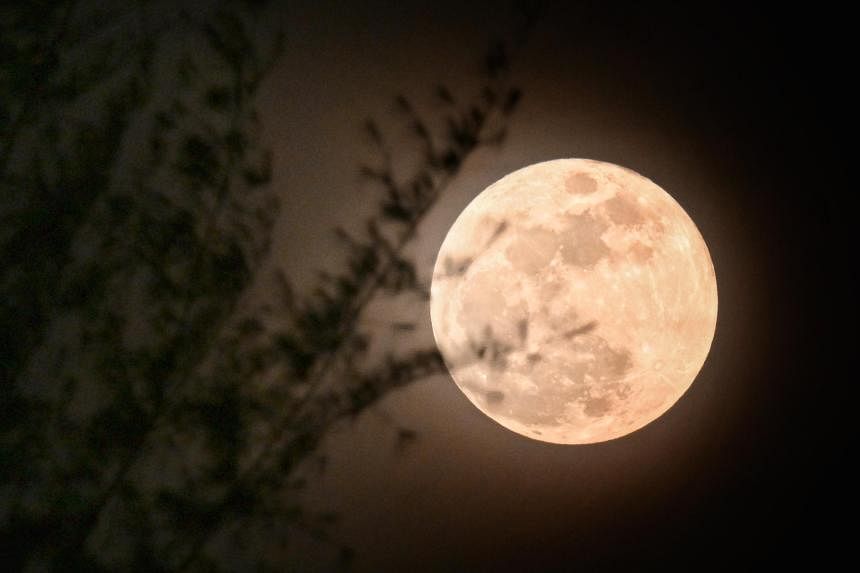SINGAPORE - The skies over the Republic will be busy in the coming weeks with a flurry of celestial activity, including two meteor showers and a supermoon.
The Lyrid meteor shower will peak in Singapore at night on April 22 till the early morning of April 23, towards the north-western sky. With records of the phenomenon stretching back almost 3,000 years, it is one of the oldest recorded meteor showers, according to timeanddate.com, a leading platform tracking time and time zones.
On April 24, a supermoon, dubbed the Pink Moon, is expected to appear after 7.22pm in the eastern sky.
Less than a fortnight later, on May 5, the Eta Aquarids meteor shower will grace the eastern sky at around 3am.
The Straits Times spoke to Ms Li Hui Mok, manager of Informal Science Programmes at the Science Centre Singapore, to find out how Singapore residents can best view these celestial phenomena.
How are meteors formed and what do meteor showers look like?
Meteor showers are formed when the Earth travels through a cloud of interplanetary debris left behind from the tail of a comet or asteroid that has thrown out large amounts of materials, said Ms Li.
“The denser the debris clouds are, the more materials will fall on Earth, thus giving us more meteors,” she added.
“While the Earth orbits the Sun and crosses into these dust streams or debris trails, the materials collide with Earth’s atmosphere and burn up, leaving a streak in the sky, which is what we see as meteors. Earth goes through these dust streaks every year, so we can predict when meteor showers will occur.”
How and why do the various meteor showers differ in their appearance?
Ms Li said meteor showers vary in the frequency of streaks of lights due to the amount of debris left by the different comets.
“The Lyrid meteor shower in Singapore may have a few short streaks of light flying across the night sky in a few minutes, compared with big banner meteor showers like the Perseid, a bright and plentiful meteor shower that usually peaks in August,” she said.
“The Lyrid does not usually leave as many glowing dust trains behind it as it streaks through the Earth’s atmosphere, but it can produce the occasional bright flash. Stargazers may witness around 20 shooting stars per hour, with sporadic flashes of light visible at night,” she added.
Where should I go to view meteor showers and do I need special equipment to do so?
Generally, meteor showers can be viewed with the naked eye if there is little or no light pollution and no cloud cover. So, find a dark spot away from city lights, with a clear, unobstructed view of the sky.
Open areas with unobstructed surroundings and less light pollution include nature parks, beaches, and reservoirs.
When viewing the meteor showers, avoid gazing directly at the radiant constellations and instead look at dark areas around them to spot the meteor streaks.
While not necessary, the use of binoculars can help a person to see fainter meteors and details in the night sky.
Ms Li further recommends that those who are keen should check out the position of the constellations, so that they can continue stargazing later into the night.
Mr Jeffrey Lim, a member of the Astronomical Society of Singapore, told ST that it is often difficult to view these events in Singapore because of the country’s high amount of light pollution and weather conditions.
He said: “We normally try to view meteor showers with our naked eye, but it can be very hard to do so. If the sky is cloudy or conditions are hazy, it becomes even harder.”
When is a moon a supermoon?
Supermoons occur when a full moon coincides with the point when the Moon is at its closest distance to Earth, Nasa said.
This point, known as perigee, can be around 50,000km closer than its farthest point from Earth, which is typically around 405,000km.
A supermoon can appear around 14 per cent bigger and up to 30 per cent brighter, timeanddate.com said.
Besides April’s Pink Moon, the phenomenon is expected to take place again in 2024 in August, September, October and November.
Mr Lim, 77, said that during viewing events held at the Science Centre Singapore, he would let the public look at the Moon using his telescope.
He said: “These celestial phenomena are not new to me, as they happen yearly and because I’ve been looking at them for so many years. But it is a good opportunity for parents to build their children’s interest about space and science.”
Correction note: In an earlier version of the story, we said that the point of perigee can be up to 65,000km closer than its farthest point from Earth, which is typically around 405,000km. This is incorrect as the nearest distance averages around 365,000km from earth and can vary up to 50,000km. We apologise for the error.


